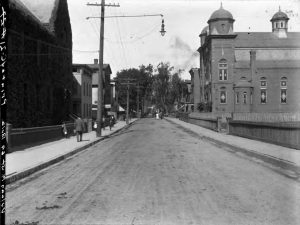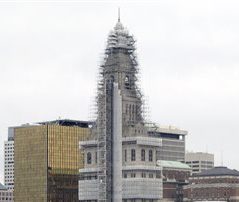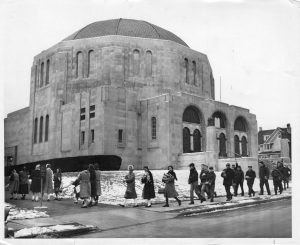The Jewish Community of Hartford, Connecticut
By: Jackson Russo
The city of Hartford Connecticut is known around the country for a handful of things. Known as the insurance capital of the world, Hartford has seen many years of prosperity and success. During the early 20th century, in the years surrounding the first world war, Hartford was home to a bustling and vibrant community of Jewish people, most of which had come from Europe.
Market street synagogue, circa 1910

This image is of Market in Hartford and of the Market street synagogue(right), circa 1910. The 1920 city directory identifies the location of Ados Israel at 250 Market Street.
One of the glass plate negatives contained in the Hartford City Parks Collection. The glass plate negatives date from approximately 1900-1930.
Historic/Current Address: Market Street (Hartford, Conn.)
The Statistics of the Community
By 1930, during the height of a phase of European immigration to the United States, Hartford as a whole had a population of roughly 160,000 people of multiple different nationalities and ethnicities. Roughly 27,000 people out of the masses were of the Jewish faith, however the exact number is extremely difficult to pinpoint. The United States Census does not separately classify a Jewish person from any other nationality, which makes it very hard to track down exact numbers of Jewish residents living anywhere within the state. According to Samuel Koenig, an esteemed professor of sociology and historian, “we are forced to rely on unofficial estimates” which would have been given to census takers by anyone and everyone who would “profess to belong to that people, regardless of country of origin.”
Why Hartford?
Regardless of the amount of members held within Hartford’s Jewish community, these people needed a reason to settle in the city itself. During this period of immigration, most Jews chose to remain in New York, which led to New York City’s Jewish population to soar above any other city in the country. By 1930, New York City had a Jewish population of 1.7 million individuals. Hartford, Connecticut housed the 5th largest Jewish community on the east coast of the United States by this time, with New Haven following right behind it. One leading hypothesis as to why some Jewish immigrants chose to settle in Connecticut rather than remain in New York is presented by Sandra Becker and Ralph Pearson. In their work The Jewish Community of Hartford, Connecticut, 1880-1929, the two present the idea that many Jewish settlers were charmed with the idea of settling in Connecticut due to the passing of a special act by the state legislature. This special act gave Jews the exact same rights and religious freedoms enjoyed by Christians since the early 19th century.
A second popular theory for the influx of Jewish immigrants to Hartford during this time was brought forth by Rabbi Abraham J. Feldman, author of the History of the Congregation of Beth Israel. Feldman theorizes that Jewish farmers and those living in the rural parts of the state would send their livestock and goods to the cities to be sold. Additionally, these farmers would send their sons to such cities, mainly Hartford, for an education. Feldman argues that these sons would go on to establish homes within the city, bolstering the city’s Jewish community. Becker and Pearson explain that these theories may not be contradictory of one another and that the passing of the 1843 legislature may have influenced the opinions of many Jewish people living in the rural parts of the area. This influence would lead them to believe that, according to Becker, “the city and state now welcomed their participation in the community.”
Much of the groundwork for what would become Hartford’s bustling Jewish community was laid out in the years surrounding and following the 1843 act by the state legislature. The Jewish community of Hartford would quickly, yet quietly become one of the cornerstones of the city itself. Its members would fulfill and provide services for much of the city, ranging from vendors and butchers to accountants and lawyers. The community would soon become one of the most integral parts of the city of Hartford.

